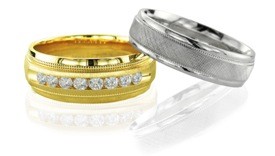White gold has for many years been chosen as a substitute for platinum because of the significant cost savings over platinum. In many cases you can save 50% – 60% over choosing the exact same jewelry made in platinum. Unfortunately, white gold does come with some maintenance issues that are not associated with platinum jewelry. If you understand the issues associated with buying white gold it can be a great choice because of the savings. However, if you purchase white gold jewelry without taking the time research or learn the problems associated with white gold you may find yourself disappointed with your decision.
Understanding White Gold
First you should understand that there is no such thing as white gold, white gold does not exist. White gold jewelry is yellow gold that is mixed with a nickel alloy; this nickel alloy makes the jewelry appear whiter than yellow gold but when placed next to platinum jewelry, it is considerably more yellow than platinum jewelry. During the final steps of the manufacturing process the more yellow looking white gold jewelry is dipped and electroplated in rhodium, which is a form of liquid platinum. In essence, white gold jewelry is simply yellow gold jewelry with a platinum skin. Over time however, the rhodium wears off and the yellow surface below bleeds through and the jewelry appears to tarnish. The tarnished look can be removed by replenishing the rhodium plating and this can be done by most local jewelers for a fee of $25 to $50. The typical white gold jewelry item must be re-plated once every 6-12 months. On the other hand, platinum jewelry is found naturally white and requires no alloys to make the jewelry look white. Jewelry made in platinum will always remain white and never requires any re-plating.
Platinum jewelry is softer than white gold yet it is much more durable than white gold jewelry. Platinum dents and dings more easily than white gold yet platinum will last significantly longer than white gold. This sounds confusing so we’ll use the following example to gain a better understanding of the difference between the two. Let’s say that you have a car and you want to replace the tires with something harder than rubber. You have a set of wooden tires (which are much harder than rubber) made and installed on the car. Do you think the wooden tires would last 25,000 miles like rubber tires? Probably Not. Even though wood is harder than rubber it certainly is not as durable as rubber. Platinum is to rubber as white gold is to wood. When comparing platinum jewelry to white gold jewelry it is virtually indestructible, and a platinum ring can last for an eternity without needing extensive maintenance. White gold rings generally do not last more than 15 – 20 years and may require new prongs, bottom shanks or heads.
View White Gold Jewelry
White gold has one big advantage over platinum and that is price, a white gold ring can cost half as much as the exact same style in platinum.
White Gold Characteristics
Pure gold jewelry is made in 24K gold and is much too impractical for everyday wear because of its softness. In order to harden the metal and increase its durability white gold jewelry is mixed with the metal alloy nickel. Most gold jewelry in the United States is mixed with alloys that bring the karat grade down to 10K, 14K, or 18K gold. The FTC (Federal Trade Commission) requires all jewelry sold to be stamped with the gold content used by the jewelry maker. To determine the exact gold content examine the jewelry for the 10K, 14K or 18K stamp, if the jewelry is not properly stamped you should be very careful before making a purchase. You may also notice that the jewelry is stamped with .417, .585, or .750 which is the percentage of pure gold. 10K = .417, 14K = .585, and 24K = .750. Sometimes you will see a stamp followed by a P like 14KP which means the gold is plumb. Gold that is plumb means that gold metal content has been verified as being 100% accurate with zero tolerance for error in the mixing process.
10K White Gold
The major benefit to buying 10k gold is the price savings, because there is less pure gold in the jewelry, the price comes down. 10K gold is very hard and resists dings and dents; however because of the lack of pure gold it is very light in color. 10K gold tarnishes over time because of the high alloy content and often needs polishing to remove the tarnish from the metal surface. 10K jewelry is considered to be lower quality jewelry. 10K gold is known to cause skin irritation because of its high alloy content.
14K White Gold
14K white gold is very affordable and is a practical choice when choosing white gold for jewelry. Unlike 10K, 14K has a more yellow color when the plating wears off because of the higher yellow gold content. It does ding and dent a little more often than 10K but polishes more easily because of its softer surface. 14K white gold is sold more often than any other white gold.
18K White Gold
18K white gold is considered to be the highest quality gold that is sold in the United States and Europe. 18K white gold has a very high yellow gold content and when the rhodium plating wears off 18k white gold jewelry can look very yellow. The softness of the metal makes it very easy to work with and it can be used to create very complex jewelry designs however, the softness also causes the ring to wear faster than 14K.
Summary
White gold is much less expensive than platinum
White gold needs occasional re-plating to make it white again
White gold does not dent or ding as easily as platinum
White gold rings last – 20 years and then need much restoration



